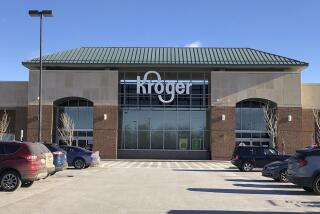Customers Can Fill Up in More Ways Than One : Marketing: Industry officials say the blending of a fast-food outlet and a gasoline station has proved popular and profitable.
- Share via
PIKEVILLE, Ky. — When Billy Bowling pulls into a Happy Mart convenience store, he fills his tank with gas and his belly with tacos.
“If you go get gas and then you go down the road and have to stand in line again for food, you’re going out of your way,” said Bowling, clutching a gas receipt and a Taco Bell bag as he climbed into his car. “It’s just less of a headache.”
Of 18 Happy Marts that Coleman Oil Co. owns in eastern Kentucky, West Virginia and Virginia, eight have big-name fast-food operations. The company plans more fast-food stations.
Industry officials say the concept is popular with consumers and profitable for gasoline distributors and fast-food chains.
The arrangement allows fast-food companies to enter new markets without shelling out $1 million or more to build a free-standing restaurant. In an economically depressed rural area like eastern Kentucky, that’s a big plus.
“It works for us because it gives us access to consumers we couldn’t normally reach,” said Bruce Schroder, vice president for Taco Bell Express. “It’s a change in marketing strategy. . . . (We are) actually taking our food to the consumers.”
These on-the-run oases started appearing about five years ago. But 1993 was the year the trend really caught on, said Stewart Small, spokesman for the National Assn. of Convenience Stores.
Last year, fast-food sales at convenience stores increased 15.3%, Small said. He said the fast-food share of convenience store sales is now 11.7%.
Industry officials have no idea how many of these hybrid stores are out there. But, Small said, “Big companies are doing it, small companies are doing it.
“It’s happening in the city, it’s happening in rural areas.”
The concept is still new enough that some of the biggest players are taking a wait-and-see attitude.
McDonald’s Corp., the nation’s No. 1 fast-food chain, has fewer than half a dozen such restaurants in its 9,500-unit empire. And they were developed on the local level, spokeswoman Ann Connolly said.
“It’s very early for us,” she said. “We’re careful. We’re taking a close look at this.”
Businesses that have tried the idea so far report impressive results.
Coleman Oil installed a Burger King at its store in Phelps, population 1,300, for about one-fifth the cost of building a free-standing restaurant. Doug Charles, vice president of Pikeville-based Coleman, said gasoline sales at the store soon jumped by as much as 500 gallons a day.
“The big thing is we already had a good existing customer base, and it allowed us to maximize our property use,” he said.
The restaurant chains won’t give figures, but the relationship appears to be working out well for them too.
When Charles started looking into adding brand-name fast food at Happy Marts 1 1/2 years ago, he had to do the courting. Now, restaurant chains are coming to the oil companies.
“Let us help you beef up your bottom line,” said a full-page Burger King ad in the June edition of Independent Gasoline Marketing magazine. “It’s never been this convenient before.”
Frank Paci, vice president for franchise sales at Burger King, said the marriage between gasoline and fast food is a natural. “They have a large similarity in the characteristic of the customers. Both businesses are very convenience-driven,” he said.
Taco Bell, which is owned by Pepsico Inc., operates 200 convenience store restaurants and plans to open another 100 by year’s end. “Our research shows that time is the currency of the ‘90s,” Schroder said.
Before Happy Mart added fast food, Pikeville residents with a hankering for Taco Bell had to drive about 70 miles to Hazard. Now, there are three Taco Bell Expresses within a few miles of each other, with more to come.
The arrangement also has allowed Baskin Robbins Inc. to expand in the area. Before linking up with Happy Marts in November, Baskin Robbins had only two stores in all of eastern Kentucky. Coleman Oil has tripled that.
“The population and the traffic just does not support the cost involved in a full-scale store,” said Baskin Robbins spokeswoman Lisa van Velthuyzen. But hook up with an existing operation, she said, “and that suddenly becomes very viable.”
Most of the fast-food operations are franchise relationships, with the gas distributor as the franchisee. But Tom Osborne, spokesman for the Society of Independent Gasoline Marketers, said some restaurant owners are becoming franchisees of the gasoline distributors.
The concept is commanding strong interest in the oil industry.
The Petroleum Marketers Assn. of America, whose members sell about half the nation’s gasoline, invited Burger King to offer a convenience store seminar at its fall convention in New Orleans.
“That room was overflowing,” said association spokesman David Morehead. “I had to have chairs brought in, and people were literally spilling into the halls. So the interest is there.”
More to Read
Inside the business of entertainment
The Wide Shot brings you news, analysis and insights on everything from streaming wars to production — and what it all means for the future.
You may occasionally receive promotional content from the Los Angeles Times.










